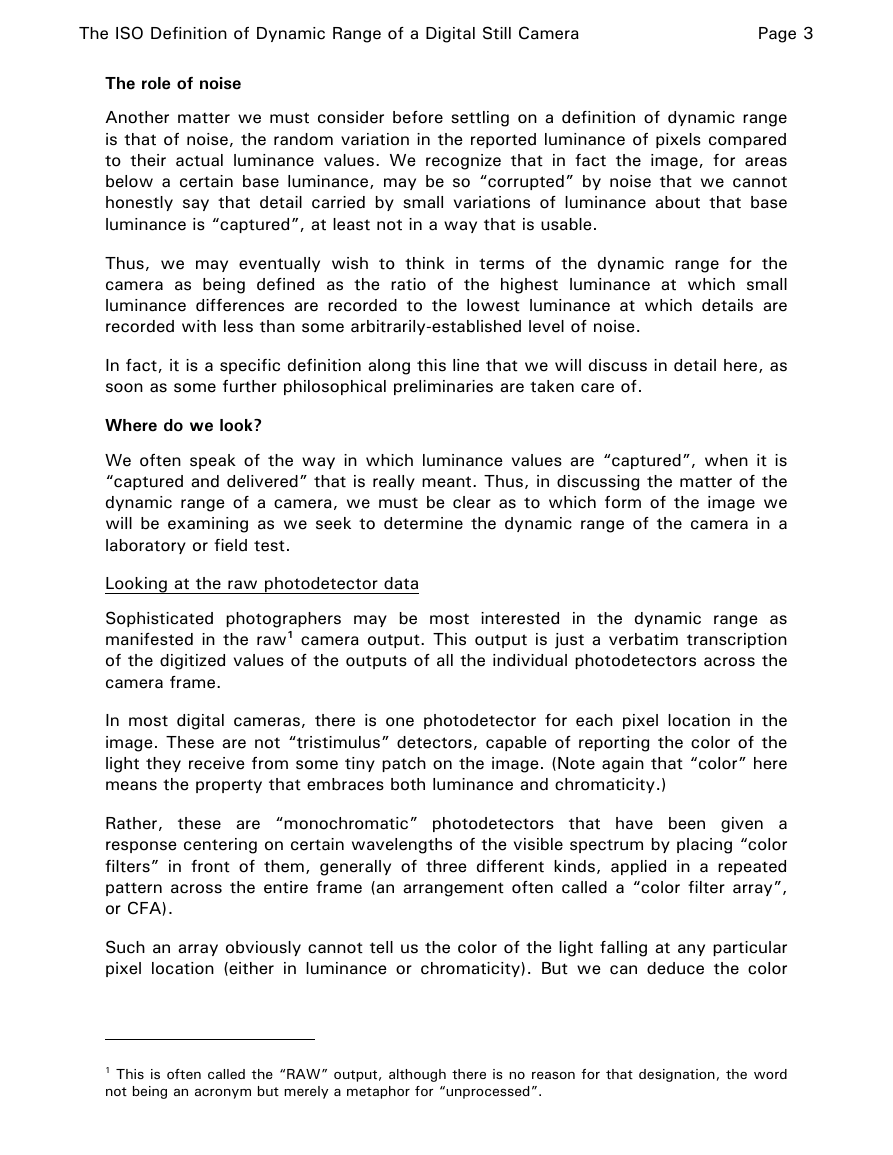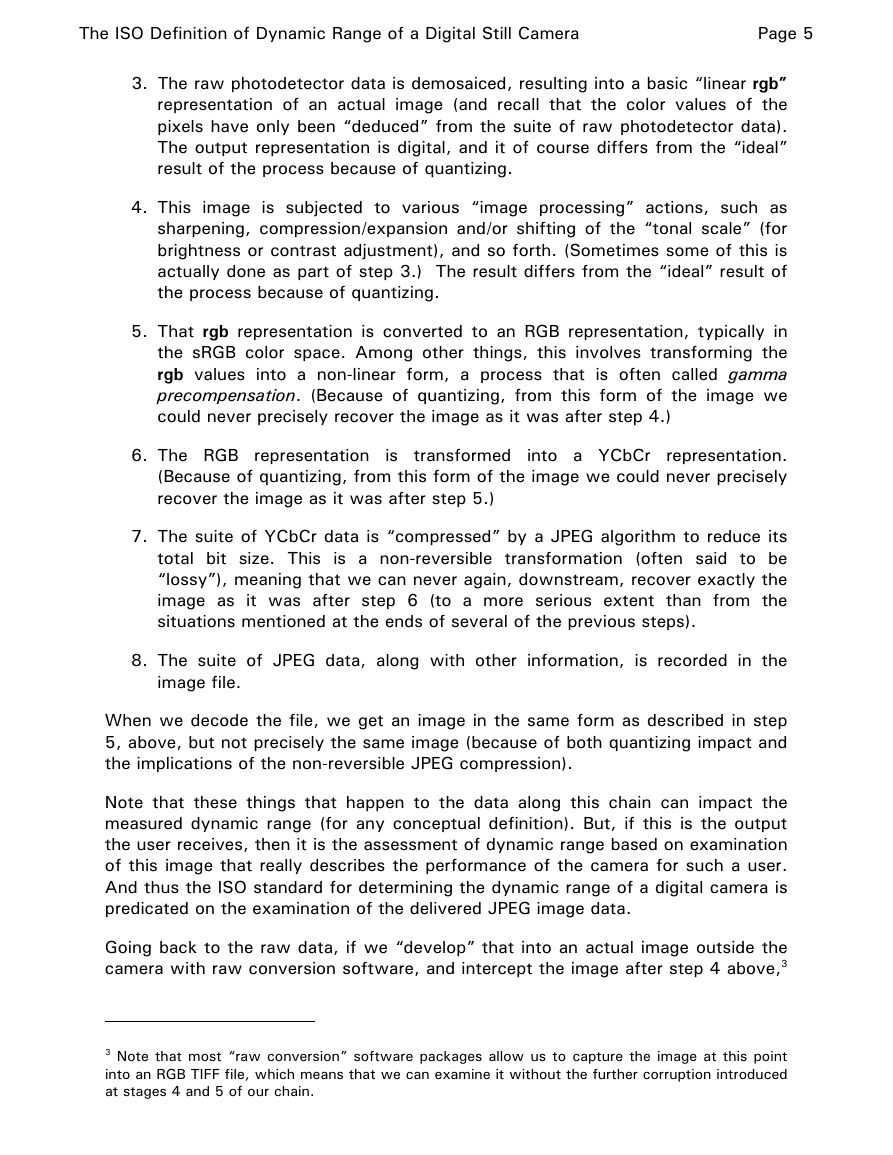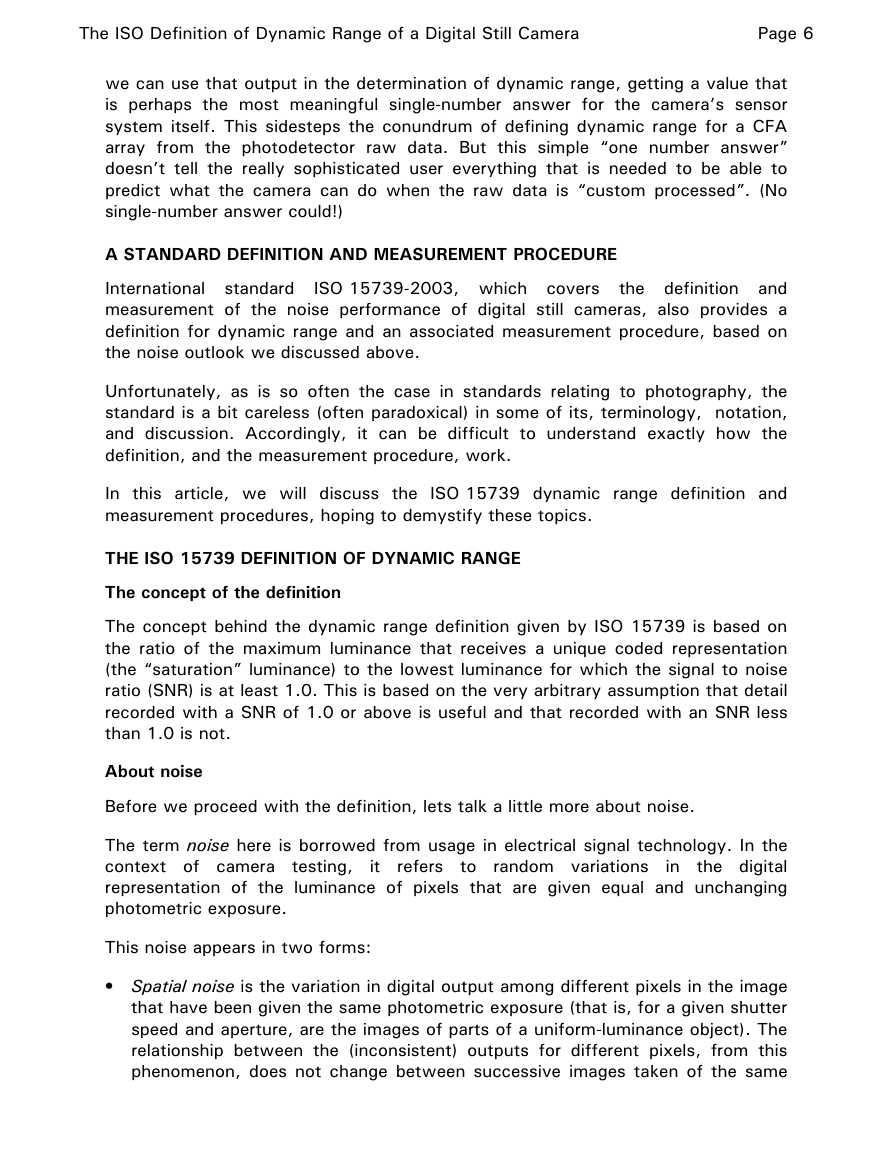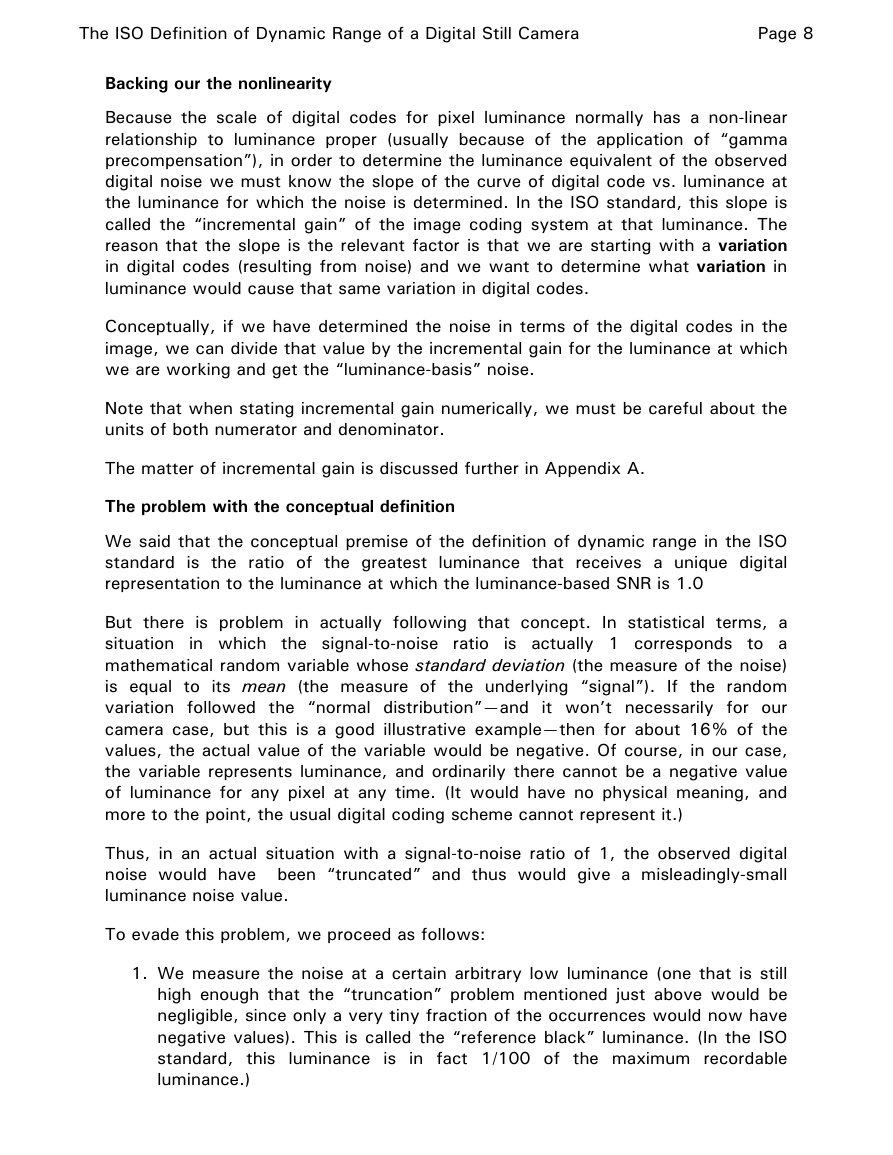The ISO Definition of the
Dynamic Range of a Digital Still Camera
Douglas A. Kerr
Issue 2
February 6, 2008
ABSTRACT
The dynamic range of a digital camera can be simplistically defined as the ratio of
the maximum and minimum luminance that a camera can “capture” in a single
exposure. But when we try to quantify this property, we find that the
establishment of an explicit definition is much more complicated than it seems on
the surface. International Standard ISO 15739-2003 gives an explicit definition of
dynamic range for a digital still camera and a procedure for determining it. This
article explains the basic concept of dynamic range and discusses some of the
complications in defining it. Then, the definition given by ISO 15739-2003 is
discussed in detail.
BACKGROUND
Dynamic range
The dynamic range of a digital camera is often (very simplistically) defined as the
ratio between the maximum and minimum luminance which, in a single image, can
be successfully “captured”. Clearly, since many scenes exhibit a large range of
luminance, having a sufficiently-large dynamic range is desirable in attempting to
completely and accurately record such scenes.
What do we really seek in our quest for “adequate” dynamic range? In general,
from a standpoint of photographic technique, what we are really trying to assure is
that, within the same “shot”:
• Detail carried by small variations in luminance about the highest local average
luminance (that is, the “highlight detail”) is captured by the camera, and,
simultaneously
• Detail carried by small variations in luminance about the lowest local average
luminance (that is, the “shadow detail”) is captured by the camera
Insufficient dynamic range for the luminance range in the scene will mean that we
cannot simultaneously achieve both of those objectives (again, in a single image).
(We can generally achieve either one by prudent choice of exposure.)
Photometric exposure and scene luminance
The physical property to which photographic film or the elements of a digital sensor
responds is photometric exposure (symbol: H). At a particular spot on the image,
this is the product of the illuminance on the film or sensor and the time it persists
(i.e., the exposure time).
�
The ISO Definition of Dynamic Range of a Digital Still Camera
Page 2
However, our basic concern is with variations in scene luminance. Because in the
discussion of dynamic range we are ordinarily making comparisons with different
parts of the same image, the aperture used, related factors such as lens
transmission and bellows factor, and the exposure time—the factors that control
the relationship between scene luminance and focal plane photometric exposure—
are fixed.
Thus, the ratio between (for example) two values of photometric exposure in an
image will be the same as the ratio between the corresponding two luminance
values in the scene. So for convenience, when discussing the response of a digital
camera sensor (since again it is only ratios that are of importance), we can speak
of the effects of a certain luminance rather than of a certain photometric exposure.
Explicit definitions of dynamic range
Often, discussions of dynamic range do not revolve around a well-formulated
definition of exactly what ratio is meant. Many times, the definition that is implied
(if not enunciated) has to do with the effect of the “quantization” of image
luminance at various stages in the processing of the image, starting with the
digitization of the analog voltage by which an individual photodetector reports the
“photometric exposure” (the illuminance-time product) to which it has been
subjected. Later impacts of quantization occur after we have deduced the specific
color of each pixel in the image (color here of course being a property that
embraces both luminance and chromaticity) from the suite of photodetector data.
For example, if at the stage of the process where we examine the digital image, we
find that the largest luminance of a scene spot that can be digitally represented has
a relative luminance of 4095 units on the applicable digital scale, and the smallest
luminance that receives a non-zero digital representation has a relative luminance of
1 unit, we may be tempted to conclude that the dynamic range of the system (as
seen at that point in the image processing chain, an important factor) is 4095
(sometimes stated as 4095:1).
But this doesn’t follow our notion of the “base” luminances for which detail, carried
by luminance variations about the base value, can be perceived.
So perhaps we need to consider the “maximum” base luminance (the numerator of
our ratio) to be 4094 (allowing detail to be recorded that varies from 4093 units to
4095), and the “minimum” base luminance (the denominator of our ratio) to be 2
units (allowing detail to be recorded that varies from 1 unit to 3). Now, our numeric
dynamic range would seem to be 2046.5:1. So we see that this little piece of
“hair-splitting” cuts our assessment of dynamic range about in half—an apparent
degradation of “one stop” to the photographer.
So perhaps this whole approach to defining dynamic range is ill advised, since the
result we get various so much with how we decide to split the hairs.
�
The ISO Definition of Dynamic Range of a Digital Still Camera
Page 3
The role of noise
Another matter we must consider before settling on a definition of dynamic range
is that of noise, the random variation in the reported luminance of pixels compared
to their actual luminance values. We recognize that in fact the image, for areas
below a certain base luminance, may be so “corrupted” by noise that we cannot
honestly say that detail carried by small variations of luminance about that base
luminance is “captured”, at least not in a way that is usable.
Thus, we may eventually wish to think in terms of the dynamic range for the
camera as being defined as the ratio of the highest luminance at which small
luminance differences are recorded to the lowest luminance at which details are
recorded with less than some arbitrarily-established level of noise.
In fact, it is a specific definition along this line that we will discuss in detail here, as
soon as some further philosophical preliminaries are taken care of.
Where do we look?
We often speak of the way in which luminance values are “captured”, when it is
“captured and delivered” that is really meant. Thus, in discussing the matter of the
dynamic range of a camera, we must be clear as to which form of the image we
will be examining as we seek to determine the dynamic range of the camera in a
laboratory or field test.
Looking at the raw photodetector data
Sophisticated photographers may be most interested in the dynamic range as
manifested in the raw1 camera output. This output is just a verbatim transcription
of the digitized values of the outputs of all the individual photodetectors across the
camera frame.
In most digital cameras, there is one photodetector for each pixel location in the
image. These are not “tristimulus” detectors, capable of reporting the color of the
light they receive from some tiny patch on the image. (Note again that “color” here
means the property that embraces both luminance and chromaticity.)
Rather, these are “monochromatic” photodetectors that have been given a
response centering on certain wavelengths of the visible spectrum by placing “color
filters” in front of them, generally of three different kinds, applied in a repeated
pattern across the entire frame (an arrangement often called a “color filter array”,
or CFA).
Such an array obviously cannot tell us the color of the light falling at any particular
pixel location (either in luminance or chromaticity). But we can deduce the color
1 This is often called the “RAW” output, although there is no reason for that designation, the word
not being an acronym but merely a metaphor for “unprocessed”.
�
The ISO Definition of Dynamic Range of a Digital Still Camera
Page 4
each pixel “probably has” by analyzing the “cloud” of photodetectors in that
neighborhood, a process called “demosaicing”.2
When we ask the camera to deliver to us an actual (“developed”) image, this
demosaicing is done inside the camera. But for much serious work, the
photographer takes the raw output, delivered by the camera in a special file format,
and applies the demosaicing later in “raw conversion” software. By doing so, the
photographer can control various parameters of the conversion in order to produce
the “best image”, especially in cases where the exposure utilized was not ideal,
where there are severe problems with the chromaticity of the incident light, and so
forth.
One result of the CFA arrangement as usually implemented is that, for any given
setting of the “ISO sensitivity” of the camera, the maximum recordable luminance
will vary between the photodetectors of the different color groups.
This situation gives some complications in deciding how to assess the dynamic
range of the camera from this perspective. Do we consider only the response of the
camera to “white” light, perhaps considering the maximum luminance to be that
which just pushes the “most sensitive” color group to its limit, and then consider
the luminance at which that same group meets our criterion (noise-based or
otherwise) as the “denominator” of the ratio?
I’m going to abandon at this point further pursuit of this line of thought, since the
dynamic range definition we will really be discussing here is implicitly predicated on
working with a “developed image”. This is in no way meant to trivialize the
importance of a good concept of dynamic range for the context of a photographer
operating with the raw data output of a camera. This is just a very complex issue
that is a proper topic for a separate essay, and which is not treated at all in the ISO
standard that is the excuse for this article.
Looking at the developed image
Of course, often the use of digital cameras is with an actual image being delivered
by the camera, often in the form of a JPEG file. It is interesting to follow the path
of the image on its way to that file.
1. Each photodetector develops an (analog) voltage that is (ideally) proportional
to luminance (assuming a certain shutter speed, aperture, and so forth), but
which may contain a random (noise) component.
2. The analog voltages from the individual photodetectors are amplified and
then digitized. The magnitude of the amplification can usually be changed by
the photographer to control the “ISO sensitivity” of the camera. (Because of
quantizing, from this digital form of the image we could never precisely
recover the photodetector data as it was in step 1.)
2 We sometimes speak of this as ”developing” the image, basking in the nostalgia of film
photography.
�
The ISO Definition of Dynamic Range of a Digital Still Camera
Page 5
3. The raw photodetector data is demosaiced, resulting into a basic “linear rgb”
representation of an actual image (and recall that the color values of the
pixels have only been “deduced” from the suite of raw photodetector data).
The output representation is digital, and it of course differs from the “ideal”
result of the process because of quantizing.
4. This image is subjected to various “image processing” actions, such as
sharpening, compression/expansion and/or shifting of the “tonal scale” (for
brightness or contrast adjustment), and so forth. (Sometimes some of this is
actually done as part of step 3.) The result differs from the “ideal” result of
the process because of quantizing.
5. That rgb representation is converted to an RGB representation, typically in
the sRGB color space. Among other things, this involves transforming the
rgb values into a non-linear form, a process that is often called gamma
precompensation. (Because of quantizing, from this form of the image we
could never precisely recover the image as it was after step 4.)
6. The RGB representation is transformed into a YCbCr representation.
(Because of quantizing, from this form of the image we could never precisely
recover the image as it was after step 5.)
7. The suite of YCbCr data is “compressed” by a JPEG algorithm to reduce its
total bit size. This is a non-reversible transformation (often said to be
“lossy”), meaning that we can never again, downstream, recover exactly the
image as it was after step 6 (to a more serious extent than from the
situations mentioned at the ends of several of the previous steps).
8. The suite of JPEG data, along with other information, is recorded in the
image file.
When we decode the file, we get an image in the same form as described in step
5, above, but not precisely the same image (because of both quantizing impact and
the implications of the non-reversible JPEG compression).
Note that these things that happen to the data along this chain can impact the
measured dynamic range (for any conceptual definition). But, if this is the output
the user receives, then it is the assessment of dynamic range based on examination
of this image that really describes the performance of the camera for such a user.
And thus the ISO standard for determining the dynamic range of a digital camera is
predicated on the examination of the delivered JPEG image data.
Going back to the raw data, if we “develop” that into an actual image outside the
camera with raw conversion software, and intercept the image after step 4 above,3
3 Note that most “raw conversion” software packages allow us to capture the image at this point
into an RGB TIFF file, which means that we can examine it without the further corruption introduced
at stages 4 and 5 of our chain.
�
The ISO Definition of Dynamic Range of a Digital Still Camera
Page 6
we can use that output in the determination of dynamic range, getting a value that
is perhaps the most meaningful single-number answer for the camera’s sensor
system itself. This sidesteps the conundrum of defining dynamic range for a CFA
array from the photodetector raw data. But this simple “one number answer”
doesn’t tell the really sophisticated user everything that is needed to be able to
predict what the camera can do when the raw data is “custom processed”. (No
single-number answer could!)
A STANDARD DEFINITION AND MEASUREMENT PROCEDURE
International standard
the definition and
measurement of the noise performance of digital still cameras, also provides a
definition for dynamic range and an associated measurement procedure, based on
the noise outlook we discussed above.
ISO 15739-2003, which covers
Unfortunately, as is so often the case in standards relating to photography, the
standard is a bit careless (often paradoxical) in some of its, terminology, notation,
and discussion. Accordingly, it can be difficult to understand exactly how the
definition, and the measurement procedure, work.
In this article, we will discuss the ISO 15739 dynamic range definition and
measurement procedures, hoping to demystify these topics.
THE ISO 15739 DEFINITION OF DYNAMIC RANGE
The concept of the definition
The concept behind the dynamic range definition given by ISO 15739 is based on
the ratio of the maximum luminance that receives a unique coded representation
(the “saturation” luminance) to the lowest luminance for which the signal to noise
ratio (SNR) is at least 1.0. This is based on the very arbitrary assumption that detail
recorded with a SNR of 1.0 or above is useful and that recorded with an SNR less
than 1.0 is not.
About noise
Before we proceed with the definition, lets talk a little more about noise.
The term noise here is borrowed from usage in electrical signal technology. In the
context of camera testing, it refers to random variations in the digital
representation of the luminance of pixels that are given equal and unchanging
photometric exposure.
This noise appears in two forms:
• Spatial noise is the variation in digital output among different pixels in the image
that have been given the same photometric exposure (that is, for a given shutter
speed and aperture, are the images of parts of a uniform-luminance object). The
relationship between the (inconsistent) outputs for different pixels, from this
phenomenon, does not change between successive images taken of the same
�
The ISO Definition of Dynamic Range of a Digital Still Camera
Page 7
object under the same exposure conditions. Not surprisingly, this noise
component is often called “fixed-pattern” noise.
• Temporal noise is the variation in the digital output from a given pixel in
successive images taken of the same object under the same exposure
conditions.
Both types of noise serve to degrade the image. Only temporal noise is taken into
account in this noise-based definition of dynamic range.
Noise on a luminance basis
The noise which is spoken of is conceptually defined on the basis of the luminance
equivalent of the noise as we observe it in the digital image. That is, if we find that
there is a certain random (noise) component in the digital code for a pixel in the
digital image, we then determine what luminance variation would produce the same
variation in the digital code, and consider this number as describing the “noise” for
use in the reckoning of “signal-to-noise ratio”. “Signal”, in this case, refers to the
actual luminance of object itself.
The measure of noise
This noise is quantified in terms the standard deviation (sigma) of the luminance
implication of the randomly-varying digital code, for a consistent actual object
luminance, over the collection of all pixels in the test region over a number of test
images, analyzed in such a way that only the temporal aspect is finally considered.4
In effect, the number we get is the average, over all the pixels in a test “block”, of
the temporal noise exhibited by the individual pixels.
Borrowing notation most commonly used in electrical engineering, we may speak of
the standard deviation as the “root mean square (RMS) deviation of the implied
luminance about its mean value. There are many reasons for the use of this
measure of the variation. One again goes back to the electrical engineering parallel
of this topic. There, the power in an electrical signal (such as the noise component
of a noisy signal) is proportional to the RMS value of the instantaneous voltage of
that signal.
Since human perception of the “potency” of a sound basically follows its power
content, we can see why the RMS value of a noise components is a useful
measure of the noise. Various rationales allow us to extend this concept to
luminance noise in an image. Thus, we use the RMS variation (the standard
deviation) of the luminance equivalent of the digital output values as our numeric
measure of the amount of noise.
4 This is wholly parallel to the practice, in electrical engineering, of using the RMS (root-mean-
square) measure of the discrepancy between a voltage signal we have and the ideal (noise-free)
signal as a measure of the noise on that signal. In fact here we often speak of the “RMS noise”.
�
The ISO Definition of Dynamic Range of a Digital Still Camera
Page 8
Backing our the nonlinearity
Because the scale of digital codes for pixel luminance normally has a non-linear
relationship to luminance proper (usually because of the application of “gamma
precompensation”), in order to determine the luminance equivalent of the observed
digital noise we must know the slope of the curve of digital code vs. luminance at
the luminance for which the noise is determined. In the ISO standard, this slope is
called the “incremental gain” of the image coding system at that luminance. The
reason that the slope is the relevant factor is that we are starting with a variation
in digital codes (resulting from noise) and we want to determine what variation in
luminance would cause that same variation in digital codes.
Conceptually, if we have determined the noise in terms of the digital codes in the
image, we can divide that value by the incremental gain for the luminance at which
we are working and get the “luminance-basis” noise.
Note that when stating incremental gain numerically, we must be careful about the
units of both numerator and denominator.
The matter of incremental gain is discussed further in Appendix A.
The problem with the conceptual definition
We said that the conceptual premise of the definition of dynamic range in the ISO
standard is the ratio of the greatest luminance that receives a unique digital
representation to the luminance at which the luminance-based SNR is 1.0
But there is problem in actually following that concept. In statistical terms, a
situation in which the signal-to-noise ratio is actually 1 corresponds to a
mathematical random variable whose standard deviation (the measure of the noise)
is equal to its mean (the measure of the underlying “signal”). If the random
variation followed the “normal distribution”—and it won’t necessarily for our
camera case, but this is a good illustrative example—then for about 16% of the
values, the actual value of the variable would be negative. Of course, in our case,
the variable represents luminance, and ordinarily there cannot be a negative value
of luminance for any pixel at any time. (It would have no physical meaning, and
more to the point, the usual digital coding scheme cannot represent it.)
Thus, in an actual situation with a signal-to-noise ratio of 1, the observed digital
noise would have been “truncated” and thus would give a misleadingly-small
luminance noise value.
To evade this problem, we proceed as follows:
1. We measure the noise at a certain arbitrary low luminance (one that is still
high enough that the “truncation” problem mentioned just above would be
negligible, since only a very tiny fraction of the occurrences would now have
negative values). This is called the “reference black” luminance. (In the ISO
standard, this luminance is in fact 1/100 of the maximum recordable
luminance.)
�
















 2023年江西萍乡中考道德与法治真题及答案.doc
2023年江西萍乡中考道德与法治真题及答案.doc 2012年重庆南川中考生物真题及答案.doc
2012年重庆南川中考生物真题及答案.doc 2013年江西师范大学地理学综合及文艺理论基础考研真题.doc
2013年江西师范大学地理学综合及文艺理论基础考研真题.doc 2020年四川甘孜小升初语文真题及答案I卷.doc
2020年四川甘孜小升初语文真题及答案I卷.doc 2020年注册岩土工程师专业基础考试真题及答案.doc
2020年注册岩土工程师专业基础考试真题及答案.doc 2023-2024学年福建省厦门市九年级上学期数学月考试题及答案.doc
2023-2024学年福建省厦门市九年级上学期数学月考试题及答案.doc 2021-2022学年辽宁省沈阳市大东区九年级上学期语文期末试题及答案.doc
2021-2022学年辽宁省沈阳市大东区九年级上学期语文期末试题及答案.doc 2022-2023学年北京东城区初三第一学期物理期末试卷及答案.doc
2022-2023学年北京东城区初三第一学期物理期末试卷及答案.doc 2018上半年江西教师资格初中地理学科知识与教学能力真题及答案.doc
2018上半年江西教师资格初中地理学科知识与教学能力真题及答案.doc 2012年河北国家公务员申论考试真题及答案-省级.doc
2012年河北国家公务员申论考试真题及答案-省级.doc 2020-2021学年江苏省扬州市江都区邵樊片九年级上学期数学第一次质量检测试题及答案.doc
2020-2021学年江苏省扬州市江都区邵樊片九年级上学期数学第一次质量检测试题及答案.doc 2022下半年黑龙江教师资格证中学综合素质真题及答案.doc
2022下半年黑龙江教师资格证中学综合素质真题及答案.doc